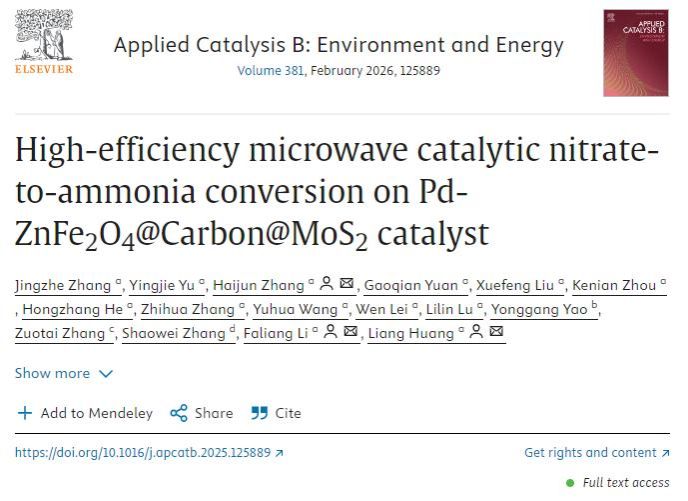Written and edited by: Cheng Yu
WUST News – The Advanced Materials Research Team at the National Key Laboratory of Advanced Refractories at Wuhan University of Science and Technology (WUST) has made significant progress in the field of environmental catalysis. Their latest research, titled High-efficiency microwave catalytic nitrate-to-ammonia conversion on Pd-ZnFe2O4@Carbon@MoS2, has been published in the top-tier international journal Applied Catalysis B: Environment and Energy (SCI impact factor 21.1).
Doctoral students Zhang Jingzhe and Yu Yingjie are the co-first authors, with Associate Professor Li Faliang, Professor Huang Liang, and Professor Zhang Haijun as corresponding authors. WUST is the first and primary completing institution.

The treatment of nitrate-contaminated water and green synthesis of ammonia represent critical challenges in environmental and energy materials research. Converting nitrates pollutants from wastewater into high-value ammonia not only mitigates environmental harm but also promotes resource recovery. However, current methods such as photocatalysis, electrocatalysis, and biocatalysis suffer from limitations such as low efficiency, high cost, and demanding reaction conditions.
This research introduces an innovative microwave catalytic reduction strategy using ZnFe2O4@Carbon@MoS2 fiber-supported Pd nanocluster catalysts, which efficiently reduce nitrates to ammonia, achieving the dual goals of wastewater treatment and resource recovery. The research team constructed a ZnFe2O4@Carbon@MoS2 support with superior microwave absorption performance through electrospinning and hydrothermal methods, then loaded Pd nanoclusters through an alcohol reduction. The nitrate reduction performance of the catalyst was systematically evaluated under microwave irradiation.
Experimental results demonstrate an outstanding ammonia production rate of 20.04 mmol·h⁻¹·L⁻¹, with the catalyst retaining high activity and stability over more than 10 reaction cycles. Through isotope labeling, in-situ spectroscopy, and DFT calculations, the team elucidated the multi synergistic mechanisms involved, including microwave “hot spot” effects that excite highly active hot electrons, enhanced nitrate adsorption by MoS₂, and reduced energy barriers facilitated by Pd nanoclusters.
Notably, this reaction can be efficiently driven using a common household microwave oven. This work not only offers a novel approach to treating high-concentration nitrate wastewater but also opens new pathways for green ammonia synthesis and sustainable nitrogen resource cycling, holding considerable scientific and practical value.